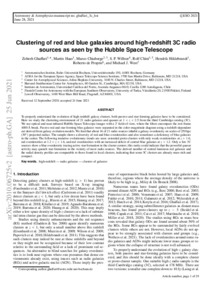Clustering of red and blue galaxies around high-redshift 3C radio sources as seen by the Hubble Space Telescope
Ghaffari Zohreh; Haas Martin; Chiaberge Marco; Willner Steven P; Chini Rolf; Hildebrandt Hendrik; de Propris Roberto; West Michael J
Clustering of red and blue galaxies around high-redshift 3C radio sources as seen by the Hubble Space Telescope
Ghaffari Zohreh
Haas Martin
Chiaberge Marco
Willner Steven P
Chini Rolf
Hildebrandt Hendrik
de Propris Roberto
West Michael J
EDP SCIENCES S A
Julkaisun pysyvä osoite on:
https://urn.fi/URN:NBN:fi-fe2021093048289
https://urn.fi/URN:NBN:fi-fe2021093048289
Tiivistelmä
To properly understand the evolution of high-redshift galaxy clusters, both passive and star-forming galaxies have to be considered. Here we study the clustering environment of 21 radio galaxies and quasars at 1z<2.5 from the third Cambridge catalog (3C). We use optical and near-infrared Hubble Space Telescope images with a 2 ' field-of-view, where the filters encompass the rest-frame 4000 angstrom break. Passive red and star-forming blue galaxies were separated in the color-magnitude diagram using a redshift-dependent cut derived from galaxy evolution models. We find that about 16 of 21 radio sources inhabit a galaxy overdensity on scales of 250 kpc (30 '') projected radius. The sample shows a diversity of red and blue overdensities and also sometimes a deficiency of blue galaxies in the center. The following tentative evolutionary trends are seen: extended proto-clusters with only weak overdensities at z>1.6, red overdensities at 1.2z<1.6, and red overdensities with an increased deficit of central blue galaxies at z<1.2. Only a few 3C sources show a blue overdensity tracing active star-formation in the cluster centers; this rarity could indicate that the powerful quasar activity may quench star-formation in the vicinity of most radio sources. The derived number of central luminous red galaxies and the radial density profiles are comparable to those found in local clusters, indicating that some 3C clusters are already mass-rich and compact.
Kokoelmat
- Rinnakkaistallenteet [27094]
